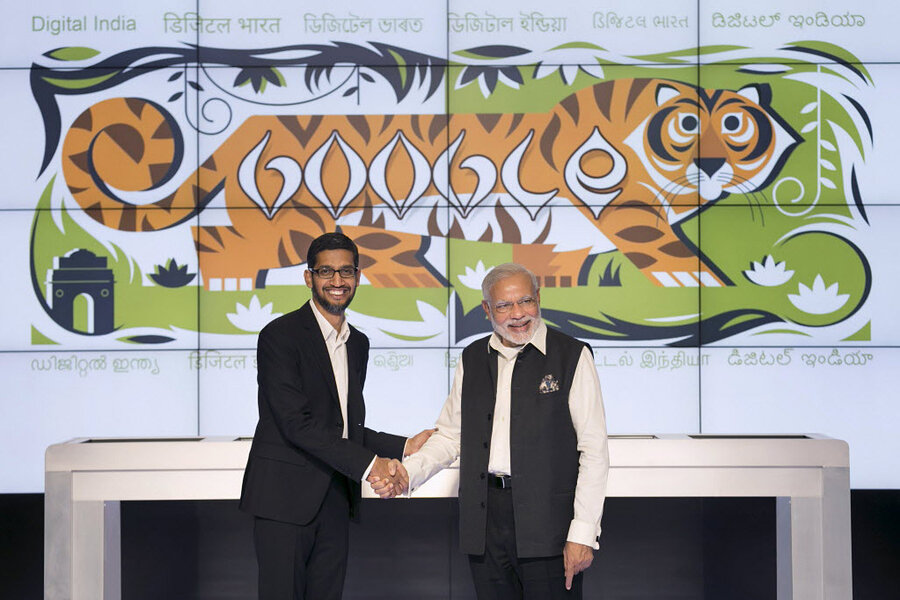Google unveils plans for revamped Android One phone for India
Loading...
In an effort to expand the company’s users in rapidly-growing markets in developing countries last year, Google unveiled a new, lower-cost smartphone called Android One.
But the phones sold poorly, with observers labeling the company’s efforts – part of a broader Google initiative to provide affordable Internet access to users in Africa, India, and the Middle East – a flop.
Now the company is making another attempt, revamping its rules on pricing and phone components in a bid to focus particularly on India, which has the world’s third largest smartphone market, behind China and the US, though the country is predicted to surpass the US by 2017.
The company is partnering with Lava International, an Indian mobile company, to release a new low-cost phone over the next few months, the Wall Street Journal reports. The company has previously said its new phones will cost between $30 and $45, compared to the previous phones, which cost about $100.
“A lot of times that first generation is in a sense meant to fail,” says Shawn Powers, a communication professor at Georgia State University who discussed the company’s international expansion in his recent book “The Real Cyberwar: The Political Economy of Internet Freedom.”
“Their goal is establish strong brand recognition and a strong group of users ... that really become evangelical brand supporters of Google and Android, that can help them expand their market,” he adds.
Google has been increasingly been making in-roads in India, where the government recently approved testing of Project Loon, which uses high-altitude balloons to broadcast Internet signals to remote areas. In September, it announced an effort to provide free wireless Internet at 400 of the country’s busiest railway stations.
Professor Powers points to a number of initiatives Google is launching to improve Internet access in the country, including a plan to provide mobile content in local languages.
But critics see a darker side to Google’s efforts to expand into developing countries. Despite its stated commitment to an open Internet, the company has embraced working with the Indian government even as the administration of Prime Minister Narendra Modi has faced criticism for efforts to block access to data the country deems illegal and for online surveillance.
“There’s compelling evidence that Internet freedom for Google is [a] marketing technique in order to improve its brand globally,” says Professor Powers.
Because Google needs government approval for efforts like the Project Loon expansion, he says, the company is choosing to favor its expansion efforts even if they conflict with Google’s wider social goals.
“The Indian government is eager to clamp down on the free flow of information to ensure that it’s not being used for illegal activities or terrorism. I think that tension’s going to come to a head and it will be interesting to see if Google stops emphasizing its role in supporting Internet freedom and rebrands itself,” he adds.
Google has long argued that’s not the case.
“Don’t get me wrong, the revenue is interesting but ... we’re here really because 10 years from now a billion Indians will be online and when we have a billion Indians online we think that’s going to make a huge difference to the global internet economy,” Rajan Anandan, the company’s managing director in India and Southeast Asia told the Financial Times in August.
When it first released Android One in India last September, Google limited phone companies to choosing from one or two options for each phone component, which had to be purchased from specific suppliers.
But the market for budget phones that cost between $50 and $100 is highly competitive, and with a number of companies making phones with similar features for a low price, local companies Micromax, Spice, and Karbonn Mobile struggled, particularly because Micromax also makes phones that run on Android but are not Android One phones.
Google’s strict requirements were intended to ensure the phones could run the latest version of Android, but for the companies, it meant more restrictions on pricing and delayed launches. This time around, companies can choose from a wider variety of options for each component, which they can purchase for their own vendors instead of ones chosen by Google, the Journal reports.
Professor Powers says that Google efforts to revamp its Android One program is a strategic decision; if the phones don’t sell at the new price, it’s possible the company will further decrease them or offer subsidies to telecommunication companies to store customers data, in a bid to attract more customers.
It’s worth it for the company, he says, because the information from mobile apps is much more valuable for the company compared to desktop platforms. Mobile apps allow access to additional user data, which can enable companies to better track a user’s buying habits for advertising purposes. This isn’t likely to change.
“It’s hard to imagine consumers forcing tech companies to change their practices as long as they’re offering value-added services in exchange for their data,” he says, mentioning the ubiquity of Google’s search engine. “That convenience is really kind of crucial and I think it will slow any kind of backlash.”







